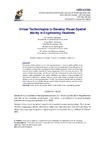Identificador persistente para citar o vincular este elemento:
https://accedacris.ulpgc.es/jspui/handle/10553/36053
| Campo DC | Valor | idioma |
|---|---|---|
| dc.contributor.author | Roca-González, Cristina | en_US |
| dc.contributor.author | Martín Gutiérrez, Jorge | en_US |
| dc.contributor.author | García-Dominguez, Melchor | en_US |
| dc.contributor.author | Mato Carrodeguas, María del Carmen | en_US |
| dc.date.accessioned | 2018-05-14T09:07:33Z | - |
| dc.date.available | 2018-05-14T09:07:33Z | - |
| dc.date.issued | 2017 | en_US |
| dc.identifier.issn | 1305-8215 | en_US |
| dc.identifier.uri | https://accedacris.ulpgc.es/handle/10553/36053 | - |
| dc.description.abstract | The present study assessed a short training experiment to improve spatial abilities using two tools based on virtual technologies: one focused on manipulation of specific geometric virtual pieces, and the other consisting of virtual orienteering game. The two tools can help improve spatial abilities required for many engineering problem-solving procedures. The results indicated that training activities improved the components of space ability (mental rotation, spatial visualization, and spatial orientation). In addition, it was concluded that there were no differences between men and women with respect to spatial ability levels before or after the training experiment. This fact resulted from masked training relating to daily living and leisure activities that are usually indistinctly performed by men and women in developed and industrialized countries. | en_US |
| dc.language | eng | en_US |
| dc.relation.ispartof | Eurasia Journal of Mathematics, Science and Technology Education | en_US |
| dc.source | Eurasia Journal of Mathematics, Science and Technology Education[ISSN 1305-8215],v. 13, p. 441-468 | en_US |
| dc.subject | 33 Ciencias tecnológicas | en_US |
| dc.subject.other | Virtual reality | en_US |
| dc.subject.other | Augmented reality | en_US |
| dc.subject.other | Spatial ability | en_US |
| dc.subject.other | Virtual orienteering | en_US |
| dc.subject.other | Gender | en_US |
| dc.title | Virtual technologies to develop visual-spatial ability in engineering students | en_US |
| dc.type | info:eu-repo/semantics/Article | en_US |
| dc.type | info:eu-repo/semantics/Article | es |
| dc.type | Article | es |
| dc.identifier.doi | 10.12973/eurasia.2017.00625a | |
| dc.identifier.scopus | 85012978060 | |
| dc.identifier.isi | 000396989100010 | - |
| dc.contributor.authorscopusid | 55853726300 | |
| dc.contributor.authorscopusid | 57211089549 | |
| dc.contributor.authorscopusid | 55971033000 | |
| dc.contributor.authorscopusid | 57193327868 | |
| dc.identifier.eissn | 1305-8223 | - |
| dc.description.lastpage | 468 | - |
| dc.identifier.issue | 2 | - |
| dc.description.firstpage | 441 | - |
| dc.relation.volume | 13 | - |
| dc.investigacion | Ingeniería y Arquitectura | en_US |
| dc.type2 | Artículo | en_US |
| dc.contributor.daisngid | 7330228 | |
| dc.contributor.daisngid | 1075402 | |
| dc.contributor.daisngid | 6988545 | |
| dc.contributor.daisngid | 11552300 | |
| dc.contributor.wosstandard | WOS:Roca-Gonzalez, C | |
| dc.contributor.wosstandard | WOS:Martin-Gutierrez, J | |
| dc.contributor.wosstandard | WOS:Garcia-Dominguez, M | |
| dc.contributor.wosstandard | WOS:Carrodeguas, MDM | |
| dc.date.coverdate | Enero 2017 | |
| dc.identifier.ulpgc | Sí | es |
| dc.description.sjr | 0,424 | |
| dc.description.sjrq | Q2 | |
| dc.description.erihplus | ERIH PLUS | |
| item.fulltext | Con texto completo | - |
| item.grantfulltext | open | - |
| crisitem.author.dept | Departamento de Cartografía y Expresión Gráfica en La Ingeniería | - |
| crisitem.author.dept | GIR IUNAT: Biología Integrativa y Recursos Biológicos | - |
| crisitem.author.dept | IU de Estudios Ambientales y Recursos Naturales | - |
| crisitem.author.orcid | 0000-0002-8557-645X | - |
| crisitem.author.orcid | 0000-0002-0992-1178 | - |
| crisitem.author.parentorg | IU de Estudios Ambientales y Recursos Naturales | - |
| crisitem.author.fullName | Roca González, María Cristina | - |
| crisitem.author.fullName | García Domínguez, Melchor | - |
| crisitem.author.fullName | Mato Carrodeguas,Maria Del Carmen | - |
| Colección: | Artículos | |
Los elementos en ULPGC accedaCRIS están protegidos por derechos de autor con todos los derechos reservados, a menos que se indique lo contrario.
